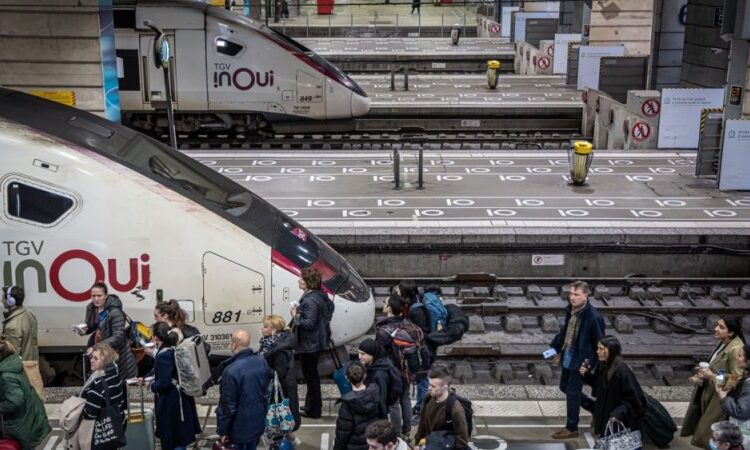
Making rail transport more competitive, investing in infrastructure, and greening transport are top priorities for SNCF, France’s state-owned railway company, according to its manifesto outlining recommendations for the next European Commission and European Parliament.
The manifesto, released last Thursday (7 March), claims rail transport is the “backbone of low-carbon mobility” and advocates for EU-level solutions to help make passenger and freight travel via rail even more efficient and environmentally friendly.
According to the International Energy Agency, rail is the most energy-efficient mode of passenger transport. Even with a relatively low carbon output, SNCF says the industry, and the transport sector as a whole, need to continue to decarbonise. The European Environment Agency says the transport sector is responsible for a quarter of the EU’s greenhouse gas emissions.
The company’s European affairs director, Jérémie Pélerin warns that “rail transport will not develop and it will not be able to play the role it could play in the decarbonisation of transport,” if EU institutions don’t follow the advice of SNCF.
Boosting competitiveness
The entire rail industry has felt pressure recently as the European Parliament’s transport committee passed its position on the Weights and Dimensions directive, voting to allow longer and heavier trucks on EU roads and across member state borders. This directive will be voted on by the entire Parliament in a plenary session on Tuesday (12 March).
“It’s true that the rail community [and] the rail freight operators [are] concerned about the directive on weights and dimensions,” said Pélerin.
“There is a high risk of modal shift from rail to road because the directive would give a competitive edge to road transport,” he added.
While Pélerin asserts the manifesto is not a response to the parliamentary committee’s position, some of the manifesto’s recommendations seem to appear to boost rail’s competitiveness so as not to render it obsolete by road transport.
For example, SNCF proposes that the transport sector internalises its external costs, like those from greenhouse gas emissions, and reflects the “true” costs of that mode of transportation in ticket prices and other charges to consumers. As the company believes rail transport is already more energy efficient than road transport, this may push consumers and shipping companies to opt for rail over road.
SNCF also recommends prohibiting the rise of “mega trucks” so that sizes of shipping containers remain compatible with train dimensions, with rail transport remaining a viable shipping option. Pélerin says banning heavier trucks would also keep roads in better shape.
The company also calls for an end to the tax reduction on fuel for heavy goods vehicles and the tax exemption for aviation, and for the differences in emissions between modes of transport to be made publicly available. This could incentivise consumers to choose rail, if they see it as a greener and less expensive alternative.
Investing in infrastructure
Another way to make rail transport more competitive and environmentally friendly is to invest in increasing capacity and electrifying the industry. SNCF calls for more seats on board trains, more frequent connections, and services to more rural areas.
However, SNCF and other train companies across Europe will need huge amounts of money to achieve this, use battery-powered trains when lines aren’t electrified, and modernise stations.
It estimates that €100 billion will be needed between now and 2040 to increase capacity and make the industry in France more efficient. While Germany’s Federal Ministry for Digital and Transport cites a figure from the European Commission of €1,500 billion required to modernise the trans-European train network.
But Pélerin says this figure likely underestimates the actual amount needed to finance the development and electrification of the entire European rail industry. The portion of the EU budget dedicated to infrastructure, and more specifically rail, isn’t sufficient to fund this endeavor, with member states unlikely to foot the bill.
“The issue at the member states’ level is budgetary policy is more restrictive because the COVID years are over,” said Pélerin.
“[The funding] can come from member states, but I think the solution is multilevel. We need to find solutions at each level of governance.”
SNCF’s manifesto calls for using revenues from the EU’s carbon market, road transport charges, aviation taxes, and private capital to fund rail infrastructure projects.
“We need to find new resources outside member states’ budgets, (and) outside traditional EU budgets,” he added.
Even if the rail sector were to receive a large influx of cash, the industry might still struggle with increasing capacity because of sector-wide staffing shortages and dissatisfaction from union employees.
“Negotiations with trade unions are always tricky,” said Pélerin. He added that the SNCF has tried to appease union employees with pay raises that align with inflation, pointing out that SNCF has hired more than 25,000 employees in 2023.
Though he admitted the EU institutions have made strides in rail-friendly legislation, there is still more to do to aid the rail industry in becoming more competitive and less carbon-intensive.
“They are just proposals,” said Pélerin of the manifesto’s contents. “They are just there to constitute debate and make change. Rail is not the only solution, but it’s part of the solution,” he added.
(Edited by Rajnish Singh)







